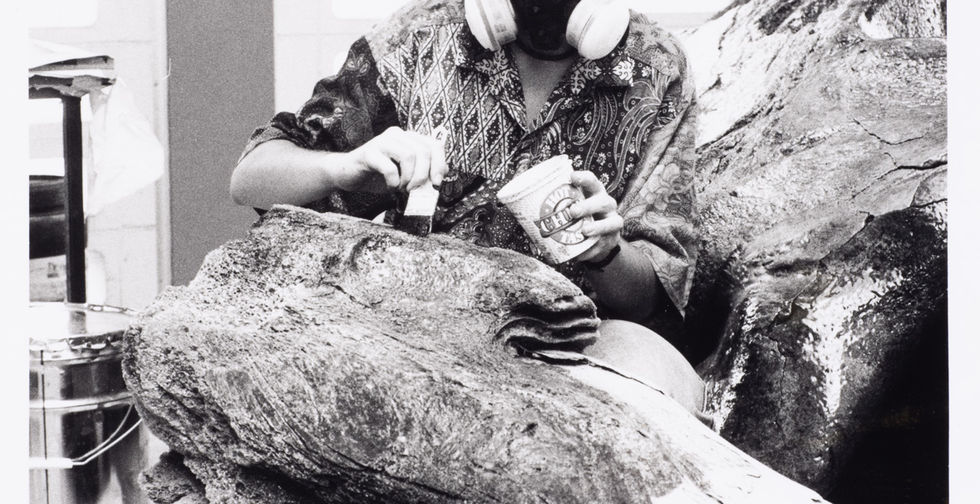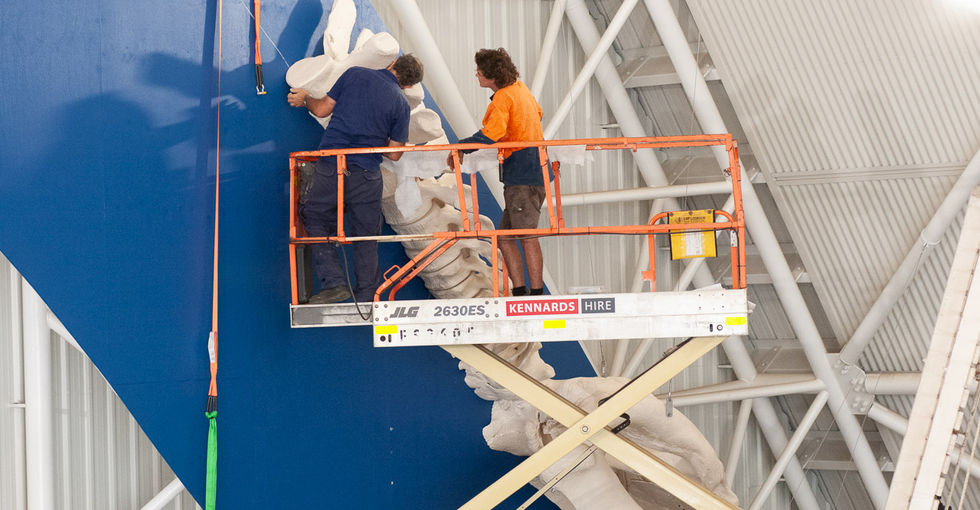Pygmy Blue Whale
(Balaenoptera musculus brevicauda)


Melville, the Northern Territoy's Pygmy Blue Whale
In 1981, museum staff recovered the weathered and fragile bones of a 21.9 metre Pygmy Blue Whale that had washed up on the coast near Cape Hotham, northeast of Darwin. The MAGNT Pygmy Blue Whale is a valuable scientific record of this endangered species in the Northern Territory.
In 1991, a decade after the bones were recovered from Cape Hotham, MAGNT officially opened the display of this unique specimen in the Maritime Gallery. It was taken down in 1999 and significant work is currently under way to revitalise and reinstate the skeleton.

Follow the visual journey of Melville's reinstallation.
1981 | Cape Hotham
1991 | The First Installation
2021-22 | The Reinstatement

Pygmy, but not small!
This skeleton belongs to a Pygmy Blue Whale, Balaenoptera musculus brevicauda, the slightly smaller subspecies of the largest animal to ever live. Full sized Blue Whales inhabit all oceans except the Arctic and have been known to reach an immense 33.6 metres long and weigh up to 180 tonnes. Our Pygmy Blue Whale, thought to originate from a population in the Indian Ocean, is 21.9 metres long, which of course is certainly not small!
Pygmy Blue Whales reside for part of the year off the coast of Western Australia and migrate north to ‘winter’ in Indonesian waters, primarily in the Banda and Molucca Seas. The northern limits of their migration are potentially for breeding and calving as well as feeding grounds. Thums et al (2022) tagged Pygmy Blue Whales from southern Australia, and near Perth and Exmouth, WA to show Biologically Important Areas (BIAs) for migration, feeding and breeding.


Image Source: Thums M et.al. (2022) Pygmy blue whale movement, distribution and important areas in the Eastern Indian Ocean.
Global Ecology & Conservation.doi.org/10.1016/j.gecco.2022.e02054 .
A Pygmy Blue Whale swims in the Indian Ocean off Sri Lanka.
Photo: Alex Mustard/Alamy Stock Photo
Blue Whales are baleen whales which means that they have become specialised for bulk feeding on small prey that congregate in large schools or swarms. They do this by taking in large mouthfuls of seawater including their prey and then filtering the prey out through bristly plates, called baleen, that hang from the roof of the mouth. Blue Whales, including Pygmy Blue Whales, feed almost entirely on krill, which are small planktonic crustaceans that live in vast swarms so dense that 500 kg can be eaten in a single mouthful.

Whales of Sea Country
For many Aboriginal and Torres Strait Islander peoples living along the coast, whales are significant Ancestral beings and animals of Sea Country, and have important roles in Ancestral creation stories and ceremonies today.
Around this continent, Aboriginal and Torres Strait Islander peoples, families and communities have their own distinct whale stories that are special to them. Such stories mark the seasonal migrations of whales, share protocols and responsibilities, and tell of specific Ancestral Beings, each with different abilities and relationships to peoples and waters. These stories are upheld and remembered in songs, ceremonies and sites through which Aboriginal and Torres Strait Islander peoples connect to their Country and to one another.
Aboriginal and Torres Strait Islander peoples have a responsibility to care for their Country and its inhabitants, as they are cared for in return. Due to these important connections, the active hunting of whales has not been practiced. It is only in rare times in the past, that a beached whale was considered as a resource for food, oil and other products. In such instances, any use of the beached whale would have been determined by each specific community’s protocols.
Many sacred and significant sites carry rock art depictions of whales, some of which date back thousands of years. These include paintings in ochres on rock shelters and petroglyphs of whales engraved into coastal rock platforms. These diverse forms of artistic and cultural storytelling show how deep and continuing these connections are between Aboriginal and Torres Strait Islander peoples and whales, and have been passed down through generations to today.

Whaling in Lamalera Village
Ancestral beliefs in the significance of whales exist throughout the coastal regions of eastern Indonesia. However the village of Lamalera on remote Lembata (Lomblen) island, Flores, is unique as it is the last location in the world where the tradition of indigenous hunting of whales continues today.

The people of Lamalera believe that whales once led their ancestors from the island of Sulawesi to Lembata in order to establish their village over six centuries ago. The ancestors subsequently gifted whale hunting skills to their descendants as a blessing for them. Today the villagers, who are now devout Roman Catholics, have incorporated Christianity and its rituals into the indigenous spiritual practices surrounding the hunt.
The annual whale season lasts from May to October. Lamalera fisherman pursue their prey using a hand-held harpoon and sailing in lashed-lug boats, known as peledang, whose style of vessel construction dates back two-thousand years. Hunting is a very dangerous occupation, even resulting in the harpooned whale dragging the boats as far as Timor which is 100 kilometres away or the crew being marooned at sea for days at a time.
The number of whales captured each season is unpredictable and may vary from none to around forty creatures. Nevertheless, whale hunting is the fundamental means of economic support on Lembata as the barrenness of the island supports little agricultural practice, like rice or corn crops. Every part of the captured whale is utilised with the meat being preserved as sundried slices for local consumption or bartered with neighbouring communities.
Today there is increasing pressure on Lamalera fishermen to cease this hunting tradition in order to support the conservation of whales but this remains a difficult challenge while there is no other source of income in this poor isolated region neighbouring Australia.




































